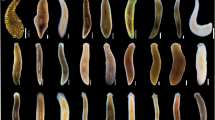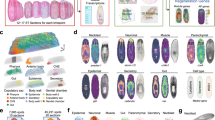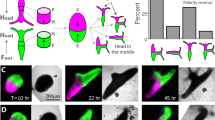Abstract
Species capable of regenerating lost body parts occur throughout the animal kingdom, yet close relatives are often regeneration incompetent1,2. Why in the face of ‘survival of the fittest’ some animals regenerate but others do not remains a fascinating question3. Planarian flatworms are well known and studied for their ability to regenerate from minute tissue pieces, yet species with limited regeneration abilities have been described even amongst planarians4. Here we report the characterization of the regeneration defect in the planarian Dendrocoelum lacteum and its successful rescue. Tissue fragments cut from the posterior half of the body of this species are unable to regenerate a head and ultimately die5. We find that this defect originates during the early stages of head specification, which require inhibition of canonical Wnt signalling in other planarian species6,7,8. Notably, RNA interference (RNAi)-mediated knockdown of Dlac-β-catenin-1, the Wnt signal transducer, restored the regeneration of fully functional heads on tail pieces, rescuing D. lacteum’s regeneration defect. Our results demonstrate the utility of comparative studies towards the reactivation of regenerative abilities in regeneration-deficient animals. Furthermore, the availability of D. lacteum as a regeneration-impaired planarian model species provides a first step towards elucidating the evolutionary mechanisms that ultimately determine why some animals regenerate and others do not.
This is a preview of subscription content, access via your institution
Access options
Subscribe to this journal
Receive 51 print issues and online access
$199.00 per year
only $3.90 per issue
Buy this article
- Purchase on Springer Link
- Instant access to full article PDF
Prices may be subject to local taxes which are calculated during checkout




Similar content being viewed by others
Accession codes
Accessions
GenBank/EMBL/DDBJ
Data deposits
The ddDlac transcriptome assembly is available at http://publications.mpi-cbg.de/5330-site. Time-course RNA-seq reads and named gene sequences have been deposited at GenBank/DDBJ/EMBL under the accession numbers GAKU00000000 (D. lacteum) and GAKV00000000 (S. mediterranea).
References
Sánchez Alvarado, A. & Tsonis, P. A. Bridging the regeneration gap: genetic insights from diverse animal models. Nature Rev. Genet. 7, 873–884 (2006)
Tanaka, E. M. Regeneration: if they can do it, why can’t we? Cell 113, 559–562 (2003)
Bely, A. E. & Nyberg, K. G. Evolution of animal regeneration: re-emergence of a field. Trends Ecol. Evol. 25, 161–170 (2010)
Brøndsted, H. V. Planarian regeneration (Pergamon Press, 1969)
Morgan, T. H. Notes on regeneration. Biol. Bull. 6, 159–172 (1904)
Gurley, K. A., Rink, J. C. & Sánchez Alvarado, A. β-catenin defines head versus tail identity during planarian regeneration and homeostasis. Science 319, 323–327 (2008)
Petersen, C. P. & Reddien, P. W. Smed-βcatenin-1 is required for anteroposterior blastema polarity in planarian regeneration. Science 319, 327–330 (2008)
Iglesias, M., Gómez-Skarmeta, J. L., Saló, E. & Adell, T. Silencing of Smed-βcatenin1 generates radial-like hypercephalized planarians. Development 135, 1215–1221 (2008)
Agata, K. & Watanabe, K. Molecular and cellular aspects of planarian regeneration. Semin. Cell Dev. Biol. 10, 377–383 (1999)
Newmark, P. A. & Sánchez Alvarado, A. Not your father’s planarian: a classic model enters the era of functional genomics. Nature Rev. Genet. 3, 210–219 (2002)
Schockaert, E. R. et al. Global diversity of free living flatworms (Platyhelminthes, ‘Turbellaria’) in freshwater. Hydrobiologia 595, 41–48 (2008)
Stéphan-Dubois, F. & Gilgenkrantz, F. Transplantation et régénération chez la planaire Dendrocoelum lacteum. J. Embryol. Exp. Morphol. 9, 642–649 (1961)
Stéphan-Dubois, F. & Bautz, A. Étude histologique et cytologique des néoblastes et des cellules fixes du parenchyme chez des planaires Dendrocoelum lacteum privées de région anterieure. Arch. Anat. Microsc. Morphol. Exp. 64, 75–89 (1975)
Sauzin-Monnot, M.-J. Etude ultrastructurale des néoblastes de Dendrocœlum lacteum au cours de la régénération. J. Ultrastruct. Res. 45, 206–222 (1973)
See Methods section included in the HTML or PDF-versions of the manuscript for further detail.
Parra, G., Bradnam, K. & Korf, I. CEGMA: a pipeline to accurately annotate core genes in eukaryotic genomes. Bioinformatics 23, 1061–1067 (2007)
Cebrià, F. et al. FGFR-related gene nou-darake restricts brain tissues to the head region of planarians. Nature 419, 620–624 (2002)
Gurley, K. A. et al. Expression of secreted Wnt pathway components reveals unexpected complexity of the planarian amputation response. Dev. Biol. 347, 24–39 (2010)
Rink, J. C. Stem cell systems and regeneration in planaria. Dev. Genes Evol. 223, 67–84 (2013)
Tanaka, E. M. & Reddien, P. W. The cellular basis for animal regeneration. Dev. Cell 21, 172–185 (2011)
Wenemoser, D., Lapan, S. W., Wilkinson, A. W., Bell, G. W. & Reddien, P. W. A molecular wound response program associated with regeneration initiation in planarians. Genes Dev. 26, 988–1002 (2012)
Reddien, P. W., Bermange, A. L., Kicza, A. M. & Sánchez Alvarado, A. BMP signaling regulates the dorsal planarian midline and is needed for asymmetric regeneration. Development 134, 4043–4051 (2007)
Petersen, C. P. & Reddien, P. W. Polarized notum activation at wounds inhibits Wnt function to promote planarian head regeneration. Science 332, 852–855 (2011)
Rink, J. C., Gurley, K. A., Elliott, S. A. & Sánchez Alvarado, A. Planarian Hh signaling regulates regeneration polarity and links Hh pathway evolution to cilia. Science 326, 1406–1410 (2009)
Beane, W. S., Morokuma, J., Adams, D. S. & Levin, M. A chemical genetics approach reveals H,K-ATPase-mediated membrane voltage is required for planarian head regeneration. Chem. Biol. 18, 77–89 (2011)
Felix, D. A. & Aboobaker, A. A. The TALE class homeobox gene Smed-prep defines the anterior compartment for head regeneration. PLoS Genet. 6, e1000915 (2010)
Blassberg, R. A., Felix, D. A., Tejada Romero, B. & Aboobaker, A. A. PBX/extradenticle is required to re-establish axial structures and polarity during planarian regeneration. Development 140, 730–739 (2013)
Chen, C.-C. G., Wang, I. E. & Reddien, P. W. pbx is required for pole and eye regeneration in planarians. Development 140, 719–729 (2013)
Petersen, C. P. & Reddien, P. W. A wound-induced Wnt expression program controls planarian regeneration polarity. Proc. Natl Acad. Sci. USA 106, 17061–17066 (2009)
Eisenhoffer, G. T., Kang, H. & Sánchez Alvarado, A. Molecular analysis of stem cells and their descendants during cell turnover and regeneration in the planarian Schmidtea mediterranea. Cell Stem Cell 3, 327–339 (2008)
Grabherr, M. G. et al. Full-length transcriptome assembly from RNA-Seq data without a reference genome. Nature Biotechnol. 29, 644–652 (2011)
Langmead, B. & Salzberg, S. L. Fast gapped-read alignment with Bowtie 2. Nature Methods 9, 357–359 (2012)
Li, H. et al. The sequence alignment/map format and SAMtools. Bioinformatics 25, 2078–2079 (2009)
Rice, P., Longden, I. & Bleasby, A. EMBOSS: The European Molecular Biology Open Software Suite. Trends Genet. 16, 276–277 (2000)
Quevillon, E. et al. InterProScan: protein domains identifier. Nucleic Acids Res. 33, W116–W120 (2005)
Altschul, S. F., Gish, W., Miller, W., Myers, E. W. & Lipman, D. J. Basic local alignment search tool. J. Mol. Biol. 215, 403–410 (1990)
Pearson, B. J. et al. Formaldehyde-based whole-mount in situ hybridization method for planarians. Dev. Dyn. 238, 443–450 (2009)
Schindelin, J. et al. Fiji: an open-source platform for biological image analysis. Nature Methods 9, 676–682 (2012)
Cebrià, F. & Newmark, P. A. Planarian homologs of netrin and netrin receptor are required for proper regeneration of the central nervous system and the maintenance of nervous system architecture. Development 132, 3691–3703 (2005)
Buchholz, F., Kittler, R., Slabicki, M. & Theis, M. Enzymatically prepared RNAi libraries. Nature Methods 3, 696–700 (2006)
Acknowledgements
We thank H. Andreas for expert animal care and colleagues at the MPI-CBG for comments.
Author information
Authors and Affiliations
Contributions
S.-Y.L., C.S., B.F., R.L. and M.V.-F. carried out experiments; A.D. contributed RNA sequencing; S.-Y.L., H.B., N.L. and I.H. carried out bioinformatics analyses; J.C.R. designed the experiments and wrote the manuscript.
Corresponding author
Ethics declarations
Competing interests
The authors declare no competing financial interests.
Supplementary information
Supplementary Information
This file contains Supplementary Figures 1-14 and additional references. (PDF 9659 kb)
Supplementary Table 1
This file contains a list of the Dlac orthologues and their corresponding transcript ID. (XLSX 13 kb)
Supplementary Table 2
This file contains the primer sequences. (XLSX 32 kb)
Rights and permissions
About this article
Cite this article
Liu, SY., Selck, C., Friedrich, B. et al. Reactivating head regrowth in a regeneration-deficient planarian species. Nature 500, 81–84 (2013). https://doi.org/10.1038/nature12414
Received:
Accepted:
Published:
Issue Date:
DOI: https://doi.org/10.1038/nature12414
This article is cited by
-
Wnt/β-catenin signalling is required for pole-specific chromatin remodeling during planarian regeneration
Nature Communications (2023)
-
Transitions and trade-offs in regeneration
Nature Ecology & Evolution (2023)
-
Evolutionary dynamics of whole-body regeneration across planarian flatworms
Nature Ecology & Evolution (2023)
-
Identification of rare, transient post-mitotic cell states that are induced by injury and required for whole-body regeneration in Schmidtea mediterranea
Nature Cell Biology (2021)
-
Animal regeneration in the era of transcriptomics
Cellular and Molecular Life Sciences (2021)
Comments
By submitting a comment you agree to abide by our Terms and Community Guidelines. If you find something abusive or that does not comply with our terms or guidelines please flag it as inappropriate.



